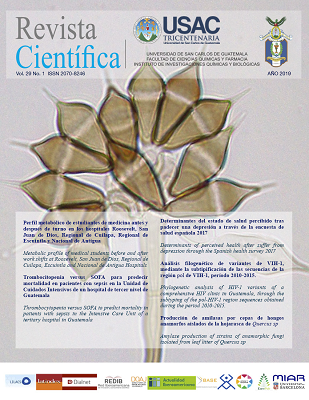Thrombocytopenia versus SOFA to predict mortality in patients with sepsis in the Intensive Care Unit of a tertiary hospital in Guatemala
DOI:
https://doi.org/10.54495/Rev.Cientifica.v29i1.46Keywords:
Organ Dysfunction Scores, Platelet Count, Sepsis, Septic ShockAbstract
The most common coagulation disorder in the intensive care unit is thrombocytopenia. Considering the fundamental role of platelets in hemostasis and as markers of disseminated intravascular coagulation, a significant decrease in platelet counts is alarming in the context of septic patients, and it is known to be a predictor of death. The objective was to compare the ability of the platelet count with the Sequential Organ Failure Assessment (SOFA) to predict death in patients with severe sepsis or septic shock. A longitudinal study was conducted with a sample of 29 consecutive cases evaluated during January to December 2015 in the Intensive Care Unit of the General Hospital of Diseases (HGE) of the Guatemalan Social Security Institute. Platelet and SOFA counts were performed at the first and the fifth day of hospitalization,
documenting the outcome of the patients. 51.7% of the patients were men and 48.3% were women, with an average age of 62.0 (16.9) years, median SOFA on admission of 10 units (Q1=4, Q3=14) and platelet median on admission of 196000 (Q1=100000, Q3=250000). e univariate association between thrombocytopenia and death was significant (p = .021, RR = 2.45, CI 95% [1.21, 4.99]). According to a Bootstrap test, there is no significant difference between the predictive capacity of SOFA and platelet count (p = .965). It was concluded that the presence of thrombocytopenia is a simple predictor of death in patients with severe sepsis or septic shock, with similar capacity to SOFA.
Downloads
References
Antier, N., Quenot, J. P., Doise, J. M., Noel, R., Demaistre, E., & Devilliers, H. (2014). Mechanisms and etiologies of thrombocytopenia in the intensive care unit : impact of extensive investigations. Annals of intensive care, 4(1), 24 .https://doi.org/10.1186/s13613-014-0024-x DOI: https://doi.org/10.1186/s13613-014-0024-x
Barton, B., & Peat, J. (2014). Medical Statistics: A Guide to SPSS, data analysis and critical appraisal (2nd ed.). Chichester, West Sussex: John Wiley & Sons.
Boechat, T. de O., Silveria, M. F. B. B. da, Faviere, W., & Macedo, G. L. de. (2012). Trombocitopenia na sepse: um importante marcador prognóstico. Revista brasileira de terapia intensiva 24(1), 35-42. https://doi.org/10.1590/S0103-507X2012000100006 DOI: https://doi.org/10.1590/S0103-507X2012000100006
Dewitte, A., Lepreux, S., Villeneuve, J., Rigothier, C., Combe, C., Ouattara, A., & Ripoche, J. (2017). Blood platelets and sepsis pathophysiology : A new therapeutic prospect in critical ill patients? Annals of intensive care, 7(1), 115. https://doi.org/10.1186/s13613-017-0337-7 DOI: https://doi.org/10.1186/s13613-017-0337-7
Erkurt, M. A., Kaya, E., Berber, I., Koroglu, M., & Kuku, I. (2012). Thrombosytopenia in adults. Journal of Hematology, 1(2-3), 44-53.
Grecco, E., Lupia, E., Bosco, O., Vizio, B., & Montrucchio, G. (2017). Platelets and Multi-Organ Failure in Sepsis. International journal of molecular sciences, 18(10), 2200. https://doi.org/10.3390/ijms18102200 DOI: https://doi.org/10.3390/ijms18102200
Greinacher, A., & Selleng, K. (2010). Thrombocytopenia in the Intensive Care Unit Patient. Hematology, 2010(1), 135-143. https://doi.org/10.1182/asheducation-2010.1.135 DOI: https://doi.org/10.1182/asheducation-2010.1.135
Guclu, E., Durmaz, Y., & Karabay O. (2013). Effect of severe sepsis on platelet count and their indices. African health sciences, 13(2), 333-338. https://doi.org/10.4314/ahs.v13i2.19 DOI: https://doi.org/10.4314/ahs.v13i2.19
Knöbl, P. (2016). Thrombopenie auf der Internsivstation. Medizinische klinik – intensivmedizin und notfallmedizin, 111(5), 425-433. https://doi.org/10.1007/s00063-016-0174-8 DOI: https://doi.org/10.1007/s00063-016-0174-8
Levi, M. (2005). Platelets in sepsis. Hematology, 10(Sepp1), 129-131. https://doi.org/10.1080/10245330512331390177 DOI: https://doi.org/10.1080/10245330512331390177
Marco-Schelke, C. M., Sánchez-Casado, M., Hostigüela-Martín, V. A., Quintana Díaz, M., Rodríguez-Villar, S., Pérez-Pedrero, M. J., … Arrese-Cosculluela. M. Á. (2012). Trombocitopenia grave al ingreso en una unidad de cuidados intensivos en pacientes con disfunción multiorgánica. Medicina intensiva 36(3), 185-192. https://doi.org/10.1016/j.medin.2011.09.011 DOI: https://doi.org/10.1016/j.medin.2011.09.011
Minne, L., Abu-Hanna, A., & de Jonge, E. (2008). Evaluation of SOFA-based models for predicting mortality in the ICU: A systematic review. Critical care, 12(6), R161. https://doi.org/10.1186/cc7160 DOI: https://doi.org/10.1186/cc7160
Mukaka, M. M. (2012). Statistics corner: A guide to appropriate use of correlation coefficient in medical research. Malawi medical journal, 24(3), 69-71.
Rhodes, A., Evans, L. E., Alhazzani, W., Levy, M. M., antonelli, M., Ferrer, R., … Dellinger, R. P. (2017). Surviving Sepsis Campaign. Critical care medicine, 45(3), 486-552. https://doi.org/10.1097/CCM.0000000000002255 DOI: https://doi.org/10.1097/CCM.0000000000002255
Smock, K. J., & Perkins, S. L. (2014). Thrombocytopenia: an update. International journal of laboratory hematology, 36(3), 269-278. https://doi.org/10.1111/ijlh.12214 DOI: https://doi.org/10.1111/ijlh.12214
Downloads
Published
How to Cite
Issue
Section
License
Copyright (c) 2019 Nancy Escobar Jímenez, Jorge Ranero Meneses, André Chocó-Cedillos

This work is licensed under a Creative Commons Attribution 4.0 International License.
Los autores/as que publiquen en esta revista aceptan las siguientes condiciones:
- Los autores/as conservan los derechos de autor y ceden a la revista el derecho de la primera publicación, con el trabajo registrado con la licencia de atribución de Creative Commons 4.0, que permite a terceros utilizar lo publicado siempre que mencionen la autoría del trabajo y a la primera publicación en esta revista.
- Los autores/as pueden realizar otros acuerdos contractuales independientes y adicionales para la distribución no exclusiva de la versión del artículo publicado en esta revista (p. ej., incluirlo en un repositorio institucional o publicarlo en un libro) siempre que indiquen claramente que el trabajo se publicó por primera vez en esta revista.
- Se permite y recomienda a los autores/as a compartir su trabajo en línea (por ejemplo: en repositorios institucionales o páginas web personales) antes y durante el proceso de envío del manuscrito, ya que puede conducir a intercambios productivos, a una mayor y más rápida citación del trabajo publicado.







